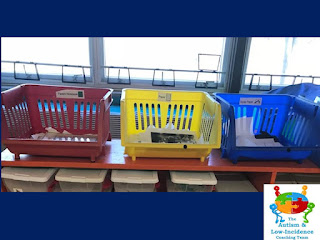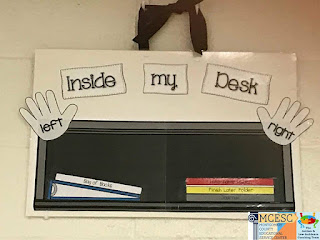Organizing Materials
Students with executive functioning differences benefit from establishing routines and designating predictable locations for materials.
Label areas for common materials,
 |
| Thematic Book Bins Kim Kohlrus Beverly Gardens Elementary, Mad River |
 |
| Turn In Bins Lindsey Woods Fairborn Primary, Fairborn |
 |
| Pencil Holders Annette Baker Miami East Elementary, Miami East |
 |
| Notebook Turn In Box Rachel Engle Horace Mann Elementary, Springfield |
 |
| Color-Coded Student Mailboxes Mandy Whitfield Learning Center- East, MCESC |
provide visual supports to help them keep their own materials organized,
 |
| Desk Organization Visual Support Annette Stine Kyle Elementary, Troy |
 |
| Student Organization Binder Allie Clements Schnell Elementary, West Carrollton |
and use visuals to cue what materials are needed for specific assignments or times of day.
 |
| Color-Coded Subject Supply Lists |
 |
| Assignment Materials Visual Catherine Anderson Rushmore Elementary, Huber Heights |
 |
| Morning Checklist Melanie Lewis Snyder Park Elementary, Springfield |
 |
| After School Checklist Leslie Mann Demmit Elementary, Vandalia |
 |
| Assignment Materials Visual Brittany Bush Spinning Hills Middle School, Mad River |
Organizing Assignments
Sometimes when a student does not readily start or complete work it may appear to be a behavior problem, however sometimes it is actually an executive functioning issue because they aren't sure where to begin, they get overwhelmed by not understanding how much work will need to be done, or they can't break down the steps of the task.
Provide visual and structural supports to break down assignments into parts to build positive momentum and communicate exactly how much needs to be done.
 |
| Visual Contract To Do List Kara Cripe Smith Elementary, Oakwood |
 |
| Get Ready-Do-Done Visual Bridgette Powers Miami East Elementary, Miami East |
 |
| Mini-Schedule |
 |
| Visual Contract Folder Susie Stoner Bradford Elementary, Bradford |
 |
| Structured Work Drawers |
Organize assignments in a predictable location and sequence to build independence.
 |
| Study Hall Assignment Organization Vicki Gomes Miami East Middle School, Miami East |
 |
| Assignment Pocket Jennifer Jette Vandalia-Butler High School, Vandalia |
 |
| Unfinished Work Folder Lori Bicknell Mound Elementary, Miamisburg |
To further reduce overwhelm, limit the visual field by folding or covering parts of the assignment. This will also build positive momentum.
 |
| Chunking Folder Mel the Literacy Coach |
Organizing Free Time
It is sometimes surprising to our teams to realize how executive functioning differences extend across all areas of functioning. Even when it comes to doing things the individual may enjoy! The concept of a "break" or "free time" may be too open-ended for the individual to visualize exactly what to do during this time.
Some teams use a designated free time area with activities students can enjoy during those times.
 |
| Reward Time Area Leslie Mann Demmitt Elementary, Vandalia |
 |
| Free Time Shelf Taylor Ruef Stevenson Elementary, Mad River |
Other teams use visual supports or reinforcement systems to help students know what their options are during free time.
 |
| Reward Time Choice Board Leslie Mann Demmitt Elementary, Vandalia |
 |
| Break Choices Laura Frank Valley Forge Elementary, Huber Heights |
 |
| Break Choices Board Gina Mattie Beverly Gardens Elementary, Mad River |
 |
| Visual Contract Erika Lauterbach Dixie Elementary, New Lebanon |
For more ideas for assisting students with planning & organization, don't miss our previous post:



No comments:
Post a Comment